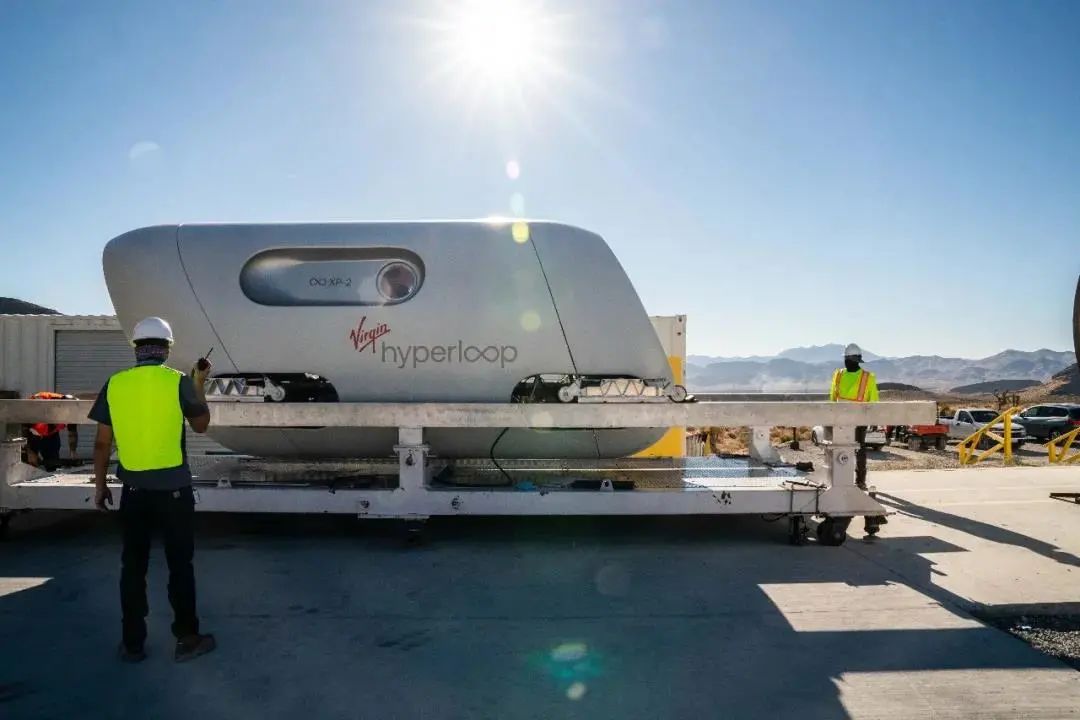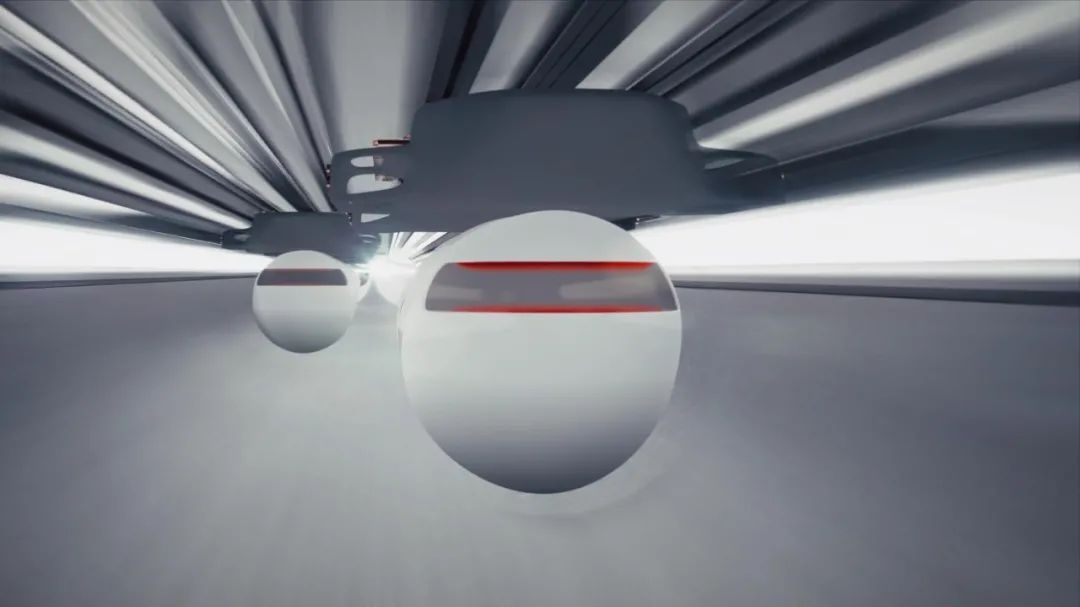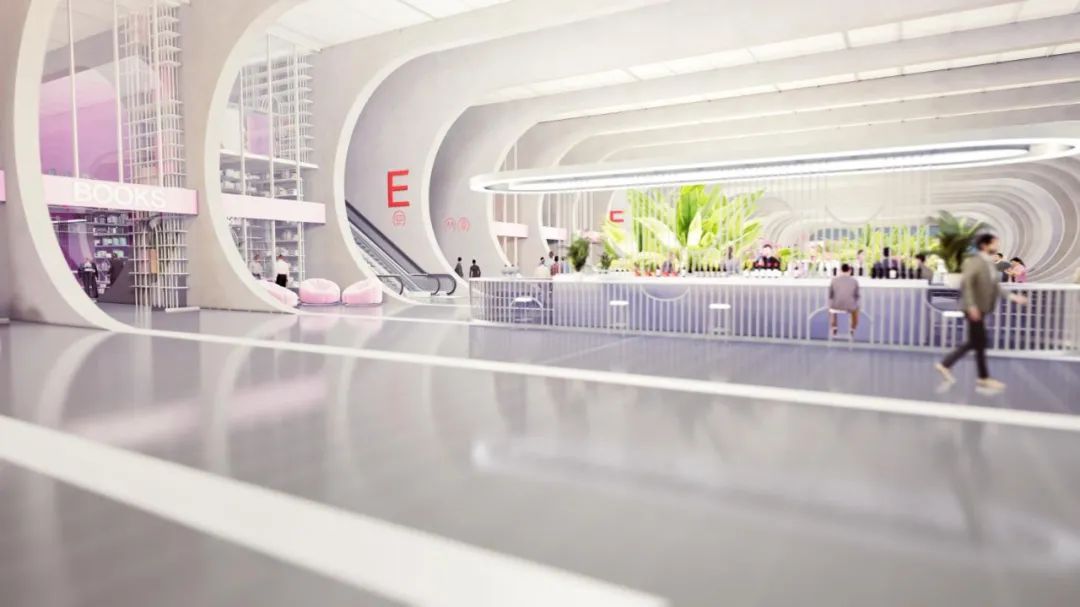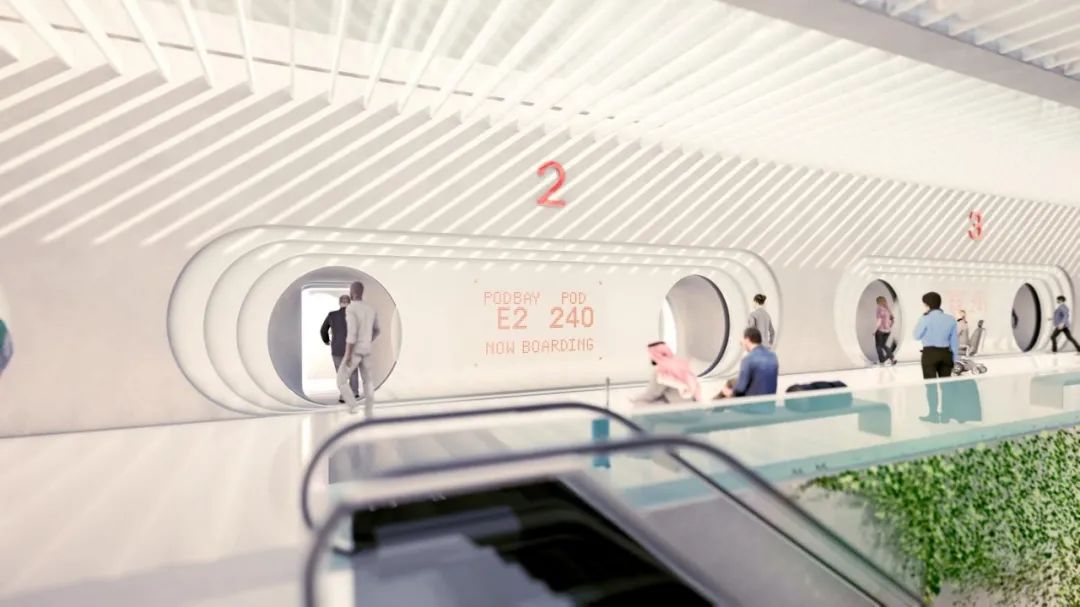- 注册
- 登录
- 小程序
- APP
- 档案号


BIG建筑事务所 · 2021-03-12 13:50:01
Virgin Hyperloop
维珍超回路列车

Virgin Hyperloop
*本文转载自英国版Wallpaper* <wallpaper*></wallpaper*>
在BIG建筑事务所设计理念的加持下,建设中的新型客货运输系统——维珍超回路列车(Virgin Hyperloop)正备受瞩目。“它是一种终点指向型的按需系统”,Bjarke Ingels说道。
The Virgin Hyperloop – a proposed mode of passenger and freight transportation – is gaining currency, aided by design ideas from BIG. 'It's about the destination,' says Bjarke Ingels

未来交通将是管道化的:至少维珍超回路列车会让你对此深信不疑。该公司近日透过一系列图片及一部短片,以乘客的视角展示了这种看似遥远的交通系统如何真正在现实中落地。超回路列车利用无摩擦的真空管道,使吊舱(车体)实现超高速运行。项目在全球范围内备受关注与赞誉。事实上,支撑这一系统的基本理论已经存在了几个世纪;在近十年之交,埃隆·马斯克(Elon Musk)才将对其的现代认知带入公众视野(埃隆·马斯克提出关于未来交通系统的愿景,即载体在几乎没有空气的管道中以760mph,即1223km/h的速度“飞行”)。
The future is all about tubes. At least, that's what Virgin Hyperloop would have you believe. The company recently released a series of images and a short film to give a flavour of how its far-future transport network will actually function from a passenger's point of view. Hyperloops, which use frictionless vacuum tubes to enable passenger pods to reach vast speeds, are gaining currency and credibility around the world. The basic concept has been around for centuries, but its modern iteration was popularised by Elon Musk at the turn of the last decade.
如今,全球许多公司都在争夺资金、合作伙伴和航线,而维珍超回路列车可能在这一领域走得最远。公司在其位于内华达州的测试轨道上进行了载人测试,并承诺将打造票价更接近汽车驾驶成本而非飞行成本的、经济实惠的商业模式。为建造这项价值数十亿美元的技术所需的庞大基础设施,BIG创始人兼创意总监Bjarke Ingels与维珍超回路列车建立了长期合作关系。
Today there are a number of companies competing for funds, partners and routes around the globe. Virgin Hyperloop is perhaps furthest down the line, running human trials on its own test tracks in Nevada, and committing themselves to creating an affordable business model that compares to the cost of driving, not flying. The architect Bjarke Ingels' firm BIG has a long-running collaboration with Virgin Hyperloop to give form to the massive infrastructure required by this multi-billion-dollar technology.
在此,我们特与Bjarke Ingels展开对话,探讨他的设计如何为这一未来交通系统奠基。
We spoke to Bjarke Ingels about how his architecture is laying the groundwork for future transportation.

维珍超回路列车将搭载大量28座单体吊舱,其内部由TEAGUE设计
英国版Wallpaper*(以下简称为W*):您从事这一项目多久了?
Wallpaper*: How long have you been working on this project?
Bjarke Ingels(以下简称为BI):这是一段漫长的旅程。我记得我们与维珍超回路列车团队的合作始于五年前。这段旅程非常有趣,我们能够参与和见证技术的不断变革、发展。在一定程度上,有机会尝试建造一种仿佛在虚空中能超高速行驶的交通工具,设计出第一辆测试成功的舱体,已经是绝对的胜利了。它无需考虑传统意义上的空气动力学(因为超回路列车的行驶管道几近真空),但仍须保证乘客能在极快的速度下舒适地旅行。我认为我们已经试着将这种理念带到最新的设计中去。大家可以说机场和火车站已经变成了购物中心,本质上将等候的时间商业化。经济诱因趋向于延迟出发并延长旅程而非缩短,而我们希望超回路列车能真正实现尽可能的直接、高效。它是一种终点指向型的按需系统( “等待大厅”与“等待”本身将一起消失;舱体将直接前往目的地,中间不做任何停留)。
Bjarke Ingels: It's been a long journey. I believe we started working with the Hyperloop guys five years ago. It's very interesting to be part of a journey where the technology has kept transforming and evolving. In that sense it felt like absolute victory to be able to design the first test vessel, to have an opportunity to try to create something that evokes speed but also feels like it travels inside a void. It's not aerodynamic in the traditional sense but it still has to be evocative of travelling at an extreme speed in great comfort. I think we've tried to bring some of that vibe to these latest designs. You could say that both airports and train stations have become shopping malls, basically commercializing the waiting time. The economic incentive has gone towards delaying departure and extending the journey rather than shortening it. What we are really trying to do with Hyperloop is to make it as blatant and as immediate as possible. It's about the destination.
W*:在空间上,物理定律似乎很大程度上决定了您的工作。那您的设计是如何适应超高速运输的需求的?
W*: It seems that the laws of physics dictate a huge amount of what you can do in terms of space. How do you accommodate these immense speeds?
BI:超回路列车系统使用真空行驶管道,因此吊舱必须通过一扇气闸,而我们的设计必须容纳这些元素。从本质上看,吊舱从正常的大气环境进入相当于外太空的环境中,故而系统结构就需要尽可能地实现无缝过渡。我们研究了各种不同的移动形式,希望能够博采众长。现代电梯“目的地派梯系统”就是一个参考。当你进入一座现代高层建筑,将想要前往的楼层告诉大楼的中控系统,系统就掌握了每个人的动向,进而对同路者进行分组派梯。这种做法既节约了乘梯时间,又减少了需用负荷。同理,当你抵达列车门户时,超回路列车系统就已经知道你的目的地,你将被直接引导到正确的吊舱(由工业设计公司TEAGUE打造)。当然,乘客可能需要等待同伴,所以建筑仍要提供舒适、美好的体验,同时也必须具备无缝且高效的导航。
BI: The system is a vacuum tube so you have to pass through an airlock, so the design has to accommodate these elements. You're essentially going from a normal atmosphere into somewhere that's equivalent to outer space. The architecture is geared towards making that transition as a seamless as possible. We looked at many different forms of mobility to see if we could combine the best of all worlds. The modern 'destination dispatch elevator' became a bit of a reference point. If you go into a modern high-rise you tell the central nervous system of the building which floor you want. It knows where everyone wants to go and groups you with the people going the same way. It reduces travel time and demand load. In a similar way, with Hyperloop you arrive at the Portal it'll already know where you’re going so you'll be directed straight to the right pod [shaped by industrial designers Teague]. The building can still be a lovely and beautiful experience, with people waiting for others to arrive, but it has to offer seamless and effortless navigation.
W*:这些是为了鼓励城市和国家进行巨额投资的概念性想法。在您个人看来,我们将在哪里看到第一个超回路列车?
W*: These are conceptual ideas that are designed to encourage cities and countries to make the colossal investment. Where do you personally think we will see the first Hyperloop?
BI:这一方面你应该与超回路列车团队交流。我认为这些研究和对话都将成为现实。
BI: You should speak to the Hyperloop guys about that. I have a feeling that all the studies and conversations are heading something that's going to be a reality.

Bjarke Ingels将维珍超回路列车设想为连接城市的“地铁系统”
W*:BIG通常会对环境做出反应,创造出适应周边环境以及未来使用社区的建筑。这种理念既展现了技术的应用,也阐明技术本质上可以融入任何文化。对于建筑师来说,这会是一种不寻常的、舍本逐末的工作方式吗?
W*: BIG usually responds to place and creates buildings that address their immediate environment and the communities that are going to use them. This concept shows how the technology works but suggests it can essentially be plugged into any culture. Is this a weird back-to-front way for an architect to work?
BI:安东尼奥•马查多(Antonio Machado,二十世纪西班牙大诗人,文学流派“九八年一代”代表人物之一)在一首美妙的诗歌中写道,“Caminante no hay Camino”,意思是“旅人,本没有道路”。这段诗写道:“旅人,本没有道路,迈步前行就是路。”当你越来越多地参与未来塑造时,你实际上就走在一条未经铺设的道路上,而不再是因循守旧,翻新、包装已完成的事物。回首时你会看到,你所迈出的步伐就是路的开端。建筑师并不习惯于这样的方式,但这是企业家精神的本质。为了使超回路列车从幻想变为现实,我们必须通过切实、可行、可达的方式来一步步实现它。在我看来,超回路列车有些像无线电和手机——许多地区跳过了固定电话的使用阶段而直接接入Wi-Fi。这也许将会在更多地区实现,因为Space X的星链(Starlink,Space X计划通过约 4000 枚相互链接的卫星和依据地理分布的地面基站,构筑一个覆盖全球的廉价太空通信系统)无处不在。同样,世界各地都有可能跳过安装数千英里常规轨道的阶段,而直接安装超回路列车。世界的中心不再是纽约或伦敦,而更像是迪拜或孟买。我敢打赌,你将在亚洲和非洲看到超回路列车对于时空的影响。
BI: There's a beautiful poem by Antonio Machado, 'Caminante no hay Camino', which means 'Wayfarer, there is no path'. It goes 'Wayfarer, there is no way. Make your way by going farther.' Increasingly, when you are involved in giving form to the future, rather than making an elegant version of something that has been done before, you are literally walking an unpaved path. When you look back, the steps you made are now the beginnings of a path. As architects, we're not used to doing that. But it is the essence of entrepreneurship. For Hyperloop to make the journey from fantasy to reality, we have to get closer and closer to materialising it in a way that is tangible, credible and desirable. I think that the Hyperloop will be a bit like wireless and cell phones, in the sense that many regions skipped the landline and gone straight to Wi-Fi – perhaps even more will once [Space X's] Starlink becomes ubiquitous and omnipresent. Similarly, there are places around the world that could skip the stage of installing thousands of miles of conventional tracks and jump straight to Hyperloop. The centre of the world isn't New York or London, it's more like Dubai or Mumbai. My bet would be that where you're really going to see the Hyperloop make a dent in space-time is among the people in Asia and Africa.
W*:那么,未来继续建造机场是否还有意义?
W*: Will there be any point in continuing to build airports in the future?
BI:作家兼理论家保罗·维希留(Paul Virilio,法国哲学家、城市理论家)的一个重要理论就是速度学(dromology),它源自希腊语中的“奔跑”一词“dromus”。他提出,虽然速度的提升会带来改变,但这并不意味着较低的速度将不复存在,相反它带来的灾难反而更小。超回路列车只是另一种高速交通工具,具有连接密集城区的优势。它就像一个全球性的“地铁系统”,但我想它联系的是整座城市,而不是某个地区。这就是它将带来巨大改变的地方。随着城市机动性的发展,我们知道任何答案都不是万能的。过去,我们认为汽车是万能的,以至于美国拆除了大量火车轨道、电车线路及地铁系统。现在我们越来越清楚的是,我们需要一种多式联运网络。而超回路列车非常适合作为数字化物理联运网络的一部分。一个人可以直接从一座城市到另一座城市,不必再从市中心前往机场。这可能正是未来城际连接中的空白点。
BI: The writer and theorist Paul Virilio had this theory of 'dromology,' from, the Greek word for 'running'. It's the idea that although increased speed changes things it doesn't mean that slower speeds cease to exist, but it has less critical impact. Hyperloop is just another avenue for delivering those high speeds, but with all the advantages of connecting dense urban areas to other dense urban areas. It's like a metro system, but a cosmopolitan one, a Cosmo, I guess, one that interconnects whole cities, not districts. This is where it will make a tremendous difference. With urban mobility, we now know that the answer is not a single silver bullet solution for everything. That’s what we thought the car was – so much so that the US ripped up all the train tracks and the tram lines and the metro systems. It's increasingly clear that what you need today is a multimodal network. The Hyperloop is incredibly well positioned to be a part of this digitally and physically connected multi-modal transportation network. An instant jump from one city to another, without having to journey out of town to an airport. It could be the missing piece in the intercity connectivity of the future.*

维珍超回路列车门户(轨道)由Bjarke Ingels及其团队设计

维珍超回路列车吊舱登舱门

可容纳28名乘客的维珍超回路列车内舱
—END—
特别声明
本文为自媒体、作者等档案号在建筑档案上传并发布,仅代表作者观点,不代表建筑档案的观点或立场,建筑档案仅提供信息发布平台。
8
好文章需要你的鼓励

 参与评论
参与评论
请回复有价值的信息,无意义的评论将很快被删除,账号将被禁止发言。
 评论区
评论区